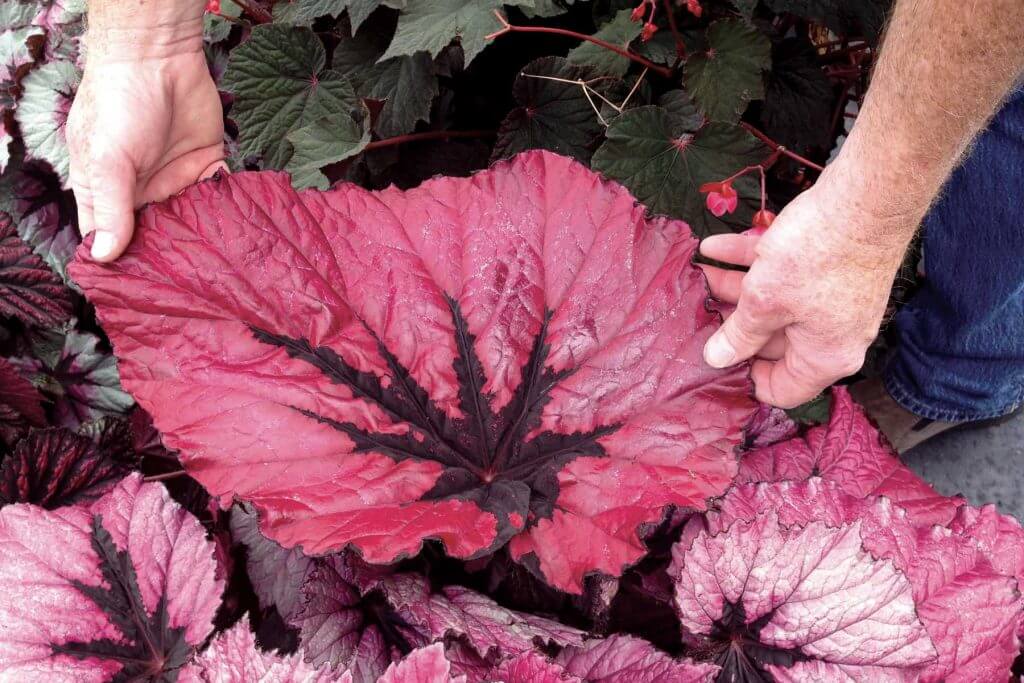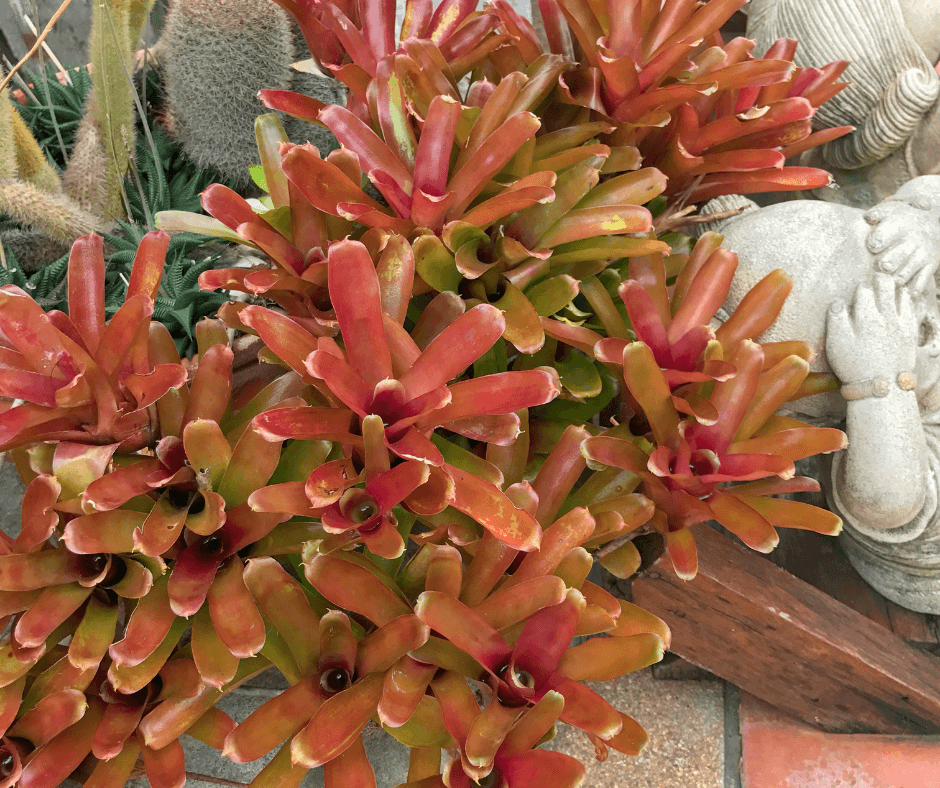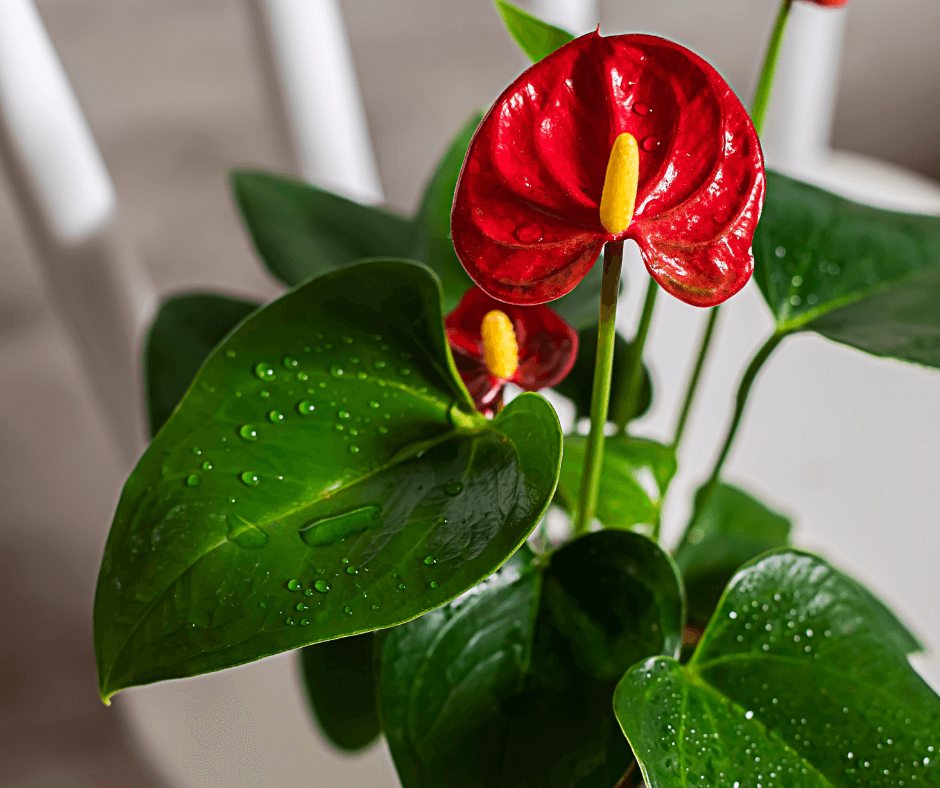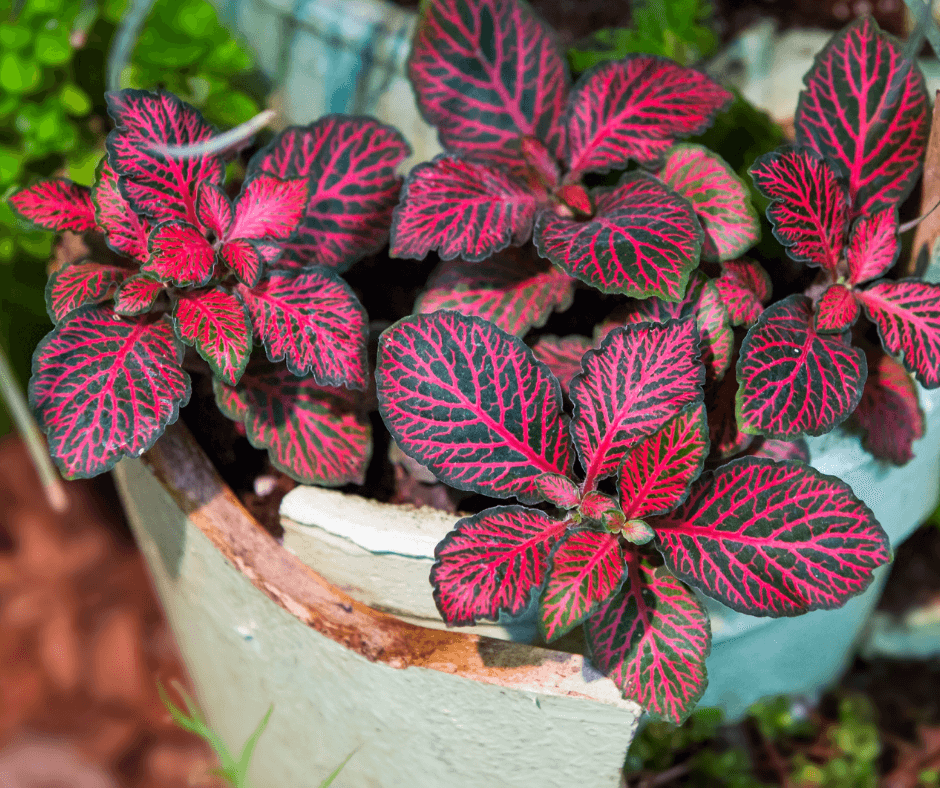
December—when the days are short and light is low—calls for maximum winter cheer. Holiday decorations are great spirit-boosters, but to add some long-term uplift, there is nothing like a splash (or two or three) of red. One of the best ways to create those cheerful splashes is to invest in a few house plants with red flowers or leaves.
The choices are many–from the leathery blooms of Anthurium to the textural leaves of the red-veined nerve plant. The best are relatively inexpensive and easy to grow for maximum joy with minimum effort.
Ruby Red Rex Begonias

Beloved since Victorian times, rex begonias are hybrids notable for their gaudy, patterned leaves–often with interesting shapes. The extra large-leaved T REX™ ‘Ruby Slippers’ is a super showstopper bred by Terra Nova Nurseries. It is vigorous and has enormous ruby-red leaves punctuated by dark purple centers. ‘Harmony’s Red Robin’ is another eye-catcher with heart-shaped leaves with black centers, wide scarlet bands, and dark brown, crinkled edges. The variety is small—about 8 inches tall at maturity—but packs a big visual punch. ‘Paso Doble’ is as exciting as the Spanish dance for which it is named, with leaves that swirl in like a snail’s shell. Each curled leaf features a bright red band against a medium green background, accented with touches of silver and maroon.
Rex begonias favor bright indoor light. Restrain the urge to water them before the soil is completely dry, but maintain relatively high humidity around the plants. There are three ways to achieve this: Mist plants regularly, set them atop water-filled pebble trays, or invest in a home humidifier. In the winter, the growth cycle slows, so plants require less water.
Bronzy-Red Bromeliads

Bromeliads are a group of tropical plants with rigid, strap-like, evergreen leaves that surround a central cup. They are longtime house plant favorites and widely available in nurseries and garden centers. Many have pink or red flowers, and some also feature red or red-blushed leaves. Neoregelia ‘Fireball‘ is compact and features narrow red leaves that spring outward from the plant’s center. The red foliage grows brighter with higher light levels, so grow the plant in the brightest indirect light. The plants reach 6 inches high and form broad, pleasing clumps of multiple rosettes. Fill the centers of the rosettes with spring water to keep the plants looking their best. Small purple flowers may bloom from the water-filled cups, particularly in the summertime.

Another more compact bromeliad, Red Star Earth Star (Cryptanthus ‘Red Star’), features rosettes of red leaves marked with a band of dark purple. The plant, which grows to about 4-6 inches tall, forms spreading clumps of showy stars as it grows. If it flowers, the blooms are inconspicuous and overshadowed by the brilliant foliage.
If you are looking for something much bigger and bolder, choose hybrid Aechmea, ‘Pinot Noir’. The light-lover can reach 3.5 feet tall and wide and features erect leaves in the shade of its namesake wine. Mature rosettes form tall, upright clusters of showy red and yellow flowers.
To make your rosy bromeliads happy, do your best to emulate conditions in their tropical homes. Free-draining soil and pots, as well as bright light, are key, as is high humidity. Mist plants or place containers atop beds of pebbles in water-filled saucers. The central cups characteristic of most bromeliads serve a practical purpose—holding water. When you water the plants, fill the cups. Springwater is recommended.
Scarlet Anthuriums

Anthurium andreanum, sometimes called “flamingo lily”, is a familiar plant at the florist or garden center. The casual observer might just see one showy red “petal”, but what appears to the be petals is actually a modified leaf (called a spathe) that surrounds an ivory or yellow floral column (called a spadix) like a cloak. Each spadex is covered with tiny flowers.
To keep your anthurium’s red spathes and green leaves in top condition keep them well dusted and clean. The plants thrive when given consistent moisture, and bright, indirect sunlight. They grow best in rich soil with lots of organic matter, such as Fafard Ultra Container Mix With Extended Feed. As with other rain forest tropicals, high humidity is a must. Since the plants often form roots close to or even atop the soil’s surface, cover them with an insulating layer of Canadian Sphagnum peat moss.
Claret Nerve Plants

Nerve plant (Fittonia spp.) is a creeping plant that provides a splash of color even in small living spaces. The “nerves” that give rise to the common name are the networks of colorful veins on the leaves and may be silver, pink, or red.
Growing 3 to 6 inches tall, and sprawling out 12 to 18 inches, nerve plant can enliven terrariums or other enclosed container gardens. It works equally well on windowsills with bright, indirect sunlight. Like other tropicals, these little creepers prefer a free-draining potting medium and consistently high humidity. Under the right conditions, the plants may sprout small, yellow, or red flowers in summer, but the leaves are the main attraction.
Less common, but still dramatic, giant nerve plant (Fittonia gigantea) grows to 2 feet, with purple stems, dark green leaves, and a network of red “nerves”.
Carmine Poinsettias

Like anthurium, poinsettias (Euphorbia pulcherrima) bear red, leaf-like bracts that resemble petals and surround the smaller true flowers. They are the archetypical Christmas plants, available in a variety of sizes and forms. Under good conditions, the red bracts may persist long beyond the December holiday season. Those conditions include bright sunlight, if possible and available, and watering when the soil surface feels dry. While most people compost or discard the plants once the bracts fade, they can be grown on. (Click here for an overview of how to keep poinsettias and other holiday house plants happy all year long.)
After the flowers fade, cut back the stems, and repot the plants in fresh potting medium. If you want the plant to rebloom in December, you must give the plants 14 hours of absolute darkness every day, beginning in late September. The poinsettia should spend the remaining ten hours of each day in the light. The best way to do this is to establish a routine of putting the plant in a dark closet a few hours before your normal bedtime and retrieving it the next morning when the 14 hours are up.

